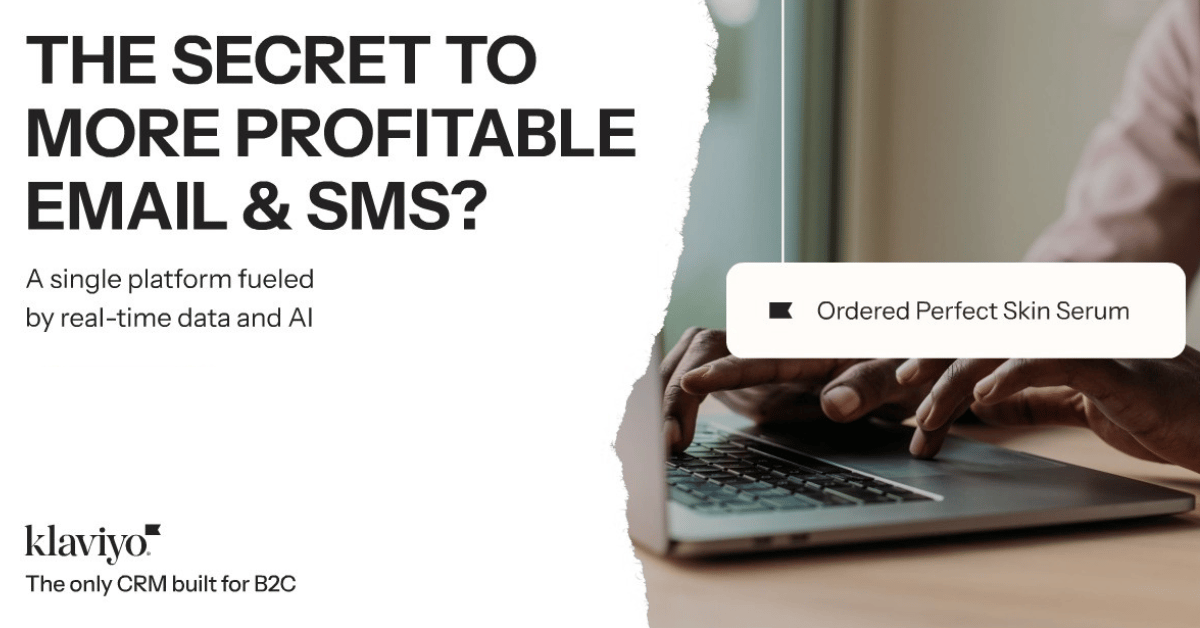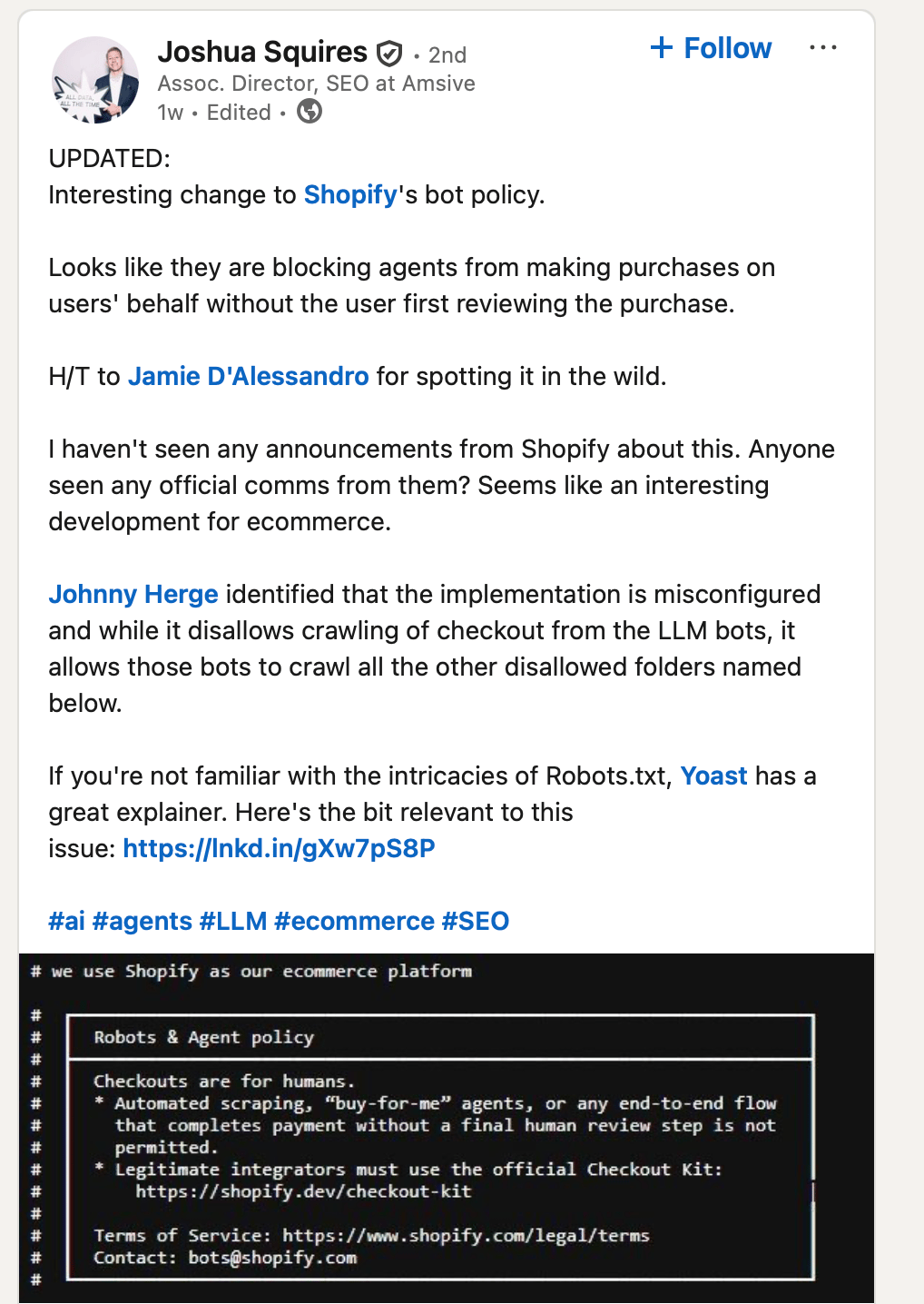- The DTC Times
- Posts
- Gmail Just Made Your Email List Smaller. Here's What's Coming Next.
Gmail Just Made Your Email List Smaller. Here's What's Coming Next.
Why subscription management tools, AI agent wars, and social commerce evolution will reshape how you reach customers and drive sales
Platform control is tightening across the board.
Gmail, TikTok, and Shopify are all making moves that will reshape how brands reach customers and drive revenue.
These changes signal a fundamental shift in how platforms monetize attention and control commerce. The brands that adapt fastest will own customer relationships while others get squeezed by platform dependency.
Today:
Macro: Gmail's subscription tool kills volume-based email strategies
Trends: TikTok auctions go live
Tactics: Shopify vs. AI agents and why the platforms will lose
Quick Hits: Links, tools, and updates worth your time
Let's dig in.
🧭 Macro: Gmail Just Killed Volume-Based Email Marketing
Gmail's "Manage Subscriptions" feature rolled out this month. Users can now see all their subscriptions sorted by frequency and unsubscribe with one click.
It’s the email equivalent of “Clean Your Closet.” And for DTC operators relying on heavy send volume to offset rising CAC, it’s a direct threat to LTV models built on broad, bloated lists.
Gmail controls 75% of U.S. webmail opens. Historically, list churn was a slow drip. You might lose 0.5 – 1% of your list each send, but slow growth and low list hygiene rarely felt existential.
But now, if Gmail decides your daily emails are spam, your list gets torched.
The interface is designed to hurt high-frequency senders. Your "most frequent" emails appear first in the cleanup queue.
Gmail is training users to view daily campaigns as clutter, and your list shrinkage will accelerate every quarter until you change strategy.
The strategy that built your list is now destroying it.
Gmail's new Manage Subscriptions feature. Good or Bad?
Marketers need to ditch lazy tactics, optimise for value, and stop blasting in desperation.
Focus on creating an great customer experiences. Adapt with personalisation. Use multichannel outreach
#EmailMarketing
— Nick Potts (@nicholaspotts)
7:28 PM • Jul 14, 2025
Most DTC brands treated email like this: send daily, boost revenue, ignore unsubscribes. Volume over value. Frequency over quality.
That playbook just died.
"Customers are looking for greater control, more meaningful content, and added value," says Omar Merlo from Imperial College London (link). "If email doesn't meet that standard, people now have a faster way to walk away."
Google is rolling out a powerful unsubscribe feature in Gmail that gives users more control and marketers a reason to rethink their email strategy.
Are you ready?
— Tomzur (@tomzur)
12:14 PM • Jul 17, 2025
But here's the twist: this might actually help you.
Unsubscribes are better than spam complaints. Clean lists outperform bloated ones every time.
The brands surviving this shift are already moving to segmentation, personalization, and genuine utility.
The spray-and-pray era is officially over.
Takeaway: Gmail's cleanup tool will shrink your list whether you control it or not. Shift to segmentation and value-based messaging now, before your daily campaigns get flagged as spam.
What If AI Could Predict Your Customer's Next Move?
Brands hit $40M+ in revenue and still can't answer basic questions like "Which customers will churn next month?" or "When will this person buy again?".
Their data lives everywhere but predictions live nowhere.
Klaviyo combines real-time insights with predictive AI, so you know what’s working and what’s coming next.
Klaviyo AI will change the way you operate:
Churn prediction: AI scores every customer's risk level and enables marketers to build automated retention flows using that data, so you can re-engage before it's too late.
Next purchase date forecasting: AI analyzes individual buying cycles and predicts when each customer is most likely to order again, so you can time campaigns and flows at the right moment.
Predictive CLV modeling: AI models forecast how much each customer will spend over time, helping you target high-value segments and increase ROI.
Knowing what comes next changes everything. With Klaviyo’s AI predictions, you can spot churn risks, forecast next purchases, and understand each customer’s long-term value before they act.
Connect your Shopify store with one click and the AI starts analyzing patterns from our historical data and automatically surfaces predictions you can use to power segments, flows, campaigns, and reporting. Within days, you’re getting accurate predictions that turn into revenue.
📊 Trends: Live Auctions Hit Social Commerce
TikTok launched "Countdown Bidding" (link), live auctions inside TikTok streams for collectibles and luxury items.
It’s a smart move. Instead of forcing auction communities into traditional ecommerce, TikTok built auctions into the platform where these buyers already hang out.
How it works
Sellers create "auction only" listings (no add-to-cart option). During live streams, they set starting bids and timeframes. Viewers bid in real-time without leaving the app.
@maxwell_finn Here is how the process of bidding on TikTok ads works. Let me know if you have any questions below!
The trust infrastructure
High-value auctions need high-trust systems.
TikTok's approach is comprehensive: pre-qualified bidders with valid payment details, return rate monitoring, and seller quality enforcement. Users with excessive returns get blocked. Sellers with "significantly not as described" complaints lose access.
The platform simultaneously raised its price cap from $7,600 to $13,000, signaling serious intent to handle premium transactions. (link)
Auction formats naturally drive higher pricing, and TikTok needed infrastructure to match.
Why this matters beyond auctions
The auction format solves 3 critical social commerce problems:
Creating urgency without discounting
Building community around purchasing decisions
Capturing premium pricing through competitive bidding
In China, Douyin generated nearly $490 billion in GMV in 2024 (link) by making shopping a social experience.
TikTok's $30 billion GMV (link) shows they're replicating successful mechanics from their Chinese counterpart.
How to plan your move
Start with limited items or drops
Pre-qualify your audience through waitlists or membership tiers
Document everything—condition, provenance, authenticity matter more in social commerce where trust is built through transparency, not marketing copy
Takeaway: TikTok proved that live auctions work in social commerce when integrated into content rather than bolted onto it. The format creates genuine urgency, fair price discovery, and entertainment value simultaneously.
⚙️ Tactics: The Great Platform vs. AI Agent War (And How to Position Your Brand)
Shopify just declared war on AI agents.
They updated their robots.txt files across all merchant stores to block "buy-for-me" agents and automated checkout flows (link).
The new directive states: "Automated scraping, 'buy-for-me' agents, or any end-to-end flow that completes payment without a final review step is not permitted."
This is a defensive move by a platform that sees its entire business model under threat.
But they're going to lose. Here's why and how to position your brand for the inevitable future.
The Market Forces Shopify Can't Stop
The global AI agents market was valued at $5.4 billion in 2024 and is projected to reach $50.31 billion by 2030, growing at a CAGR of 45.8% (link).
More critically, 69% of retailers using AI agents report significant revenue growth due to improved personalization and predictive analytics (link).
Major players are already moving:
Amazon is testing a "buy-for-me" feature that can purchase items from third-party websites for customers
Walmart has launched a generative assistant, Sparky, that executives say could evolve into a full-fledged personal shopping agent that doesn't need human inputs to complete tasks
Why Shopify's Technical Blocks Won't Work
Shopify merchants could theoretically override the robots.txt file. But the real problem is deeper. Companies are already building around these restrictions.
Companies like Skyfire offer "Agent Checkout" that turns any website into an API for AI consumption.
When "an AI agent can compress browsing, selection and checkout into the same dialogue, retailers that sit outside the conversation risk ceding both visibility and sales" (link).
The contradiction in Shopify's strategy is telling.
They partner with OpenAI for search while blocking AI from buying. They want agents to discover products but not complete purchases.
Agentic commerce is unquestionably going to increase online commerce
Will it go more to Shopify or Amazon?
I’d personally bet Shopify - AI increases ease of knowledge (and therefore trust) which means it’s more leverage for small independent stores
— Rishabh Jain (@rishabhmjain)
5:37 PM • Jul 12, 2025
This half-measure approach signals they know AI agents are inevitable but hope to control the terms. At least for now…
The Real Threat to Platforms
What Shopify really fears: AI agents don't care about checkout flows, brand storytelling, or platform lock-in. They optimize for specs, reviews, and prices.
When agents handle transactions, platforms become invisible infrastructure.
This commoditization threat is existential. If agents can shop anywhere, platform differentiation disappears.
How Smart Brands Are Already Preparing
The brands that win are building for AI-first commerce now. Here's their playbook:
1. Optimize for Machine Discovery
AI agents don't browse, they query. Your success depends on how well machines can find, evaluate, and purchase your products.
Critical actions:
Audit your structured data: Product specs, inventory status, pricing, and availability must be machine-readable
Clean your product information: AI agents need accurate dimensions, materials, compatibility, and usage data
Test API accessibility: Can automated systems access your product catalog without human intervention?
Implement real-time inventory feeds: Agents won't wait for manual updates
2. Build Direct Customer Relationships
81% of customers prefer AI-driven self-service options, and businesses achieve 76% higher e-commerce efficiency with AI agents (link). Don't let platforms own these relationships.
Strategic moves:
Develop your own AI interfaces: Direct customer interaction beats platform mediation
Create agent-friendly APIs: Make it easier for AI to work with you directly
Build loyalty beyond platforms: Email, SMS, and direct channels become critical
Document everything comprehensively: Agents reward detailed, accurate information
3. Position for the Platform Wars
The added language directs "legitimate integrators" to use its official Checkout Kit (link). Every platform will launch "official" AI tools that keep them in control.
Your decision matrix:
Play by platform rules: Use official integrations but accept dependency
Build platform independence: Invest in direct agent relationships
Hedge your bets: Develop both official and independent capabilities
The Inevitable Outcome
51% of companies worldwide are actively researching AI agents while 37% are already experimenting with them. AI agents are expected to automate 15% to 50% of business tasks by 2027 (link).
The market has spoken. AI agents will handle more commerce transactions every quarter.
Platforms can slow adoption, but they can't stop it.
The smart play: Start optimizing for AI agents today. The brands that get ahead of this will own customer relationships when agents become the primary shopping interface.
Takeaway: Don’t ignore this. Start prepping your brand’s data, tech stack, and channel strategy for an agent-powered commerce world. Even if Shopify is holding the door closed for now.
⚡ Quick Hits
Trump's three-month tariff pause expires August 1. The temporary relief is about to become permanent pain
73% of marketers report rising CACs, but only 14% prioritize retention over acquisition (Klaviyo 2025 State of B2C Marketing)
U.S. startup funding soared to $162.8B in the first half of 2025, marking the strongest half-year since 2021 and fueled largely by investments in AI-powered D2C and tech platforms
Levi’s raised its outlook as Beyoncé and Shaboozey collabs helped offset soft demand and tariffs.


Reply